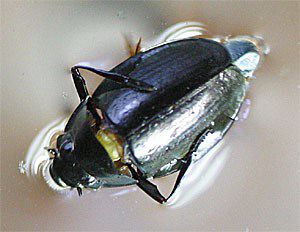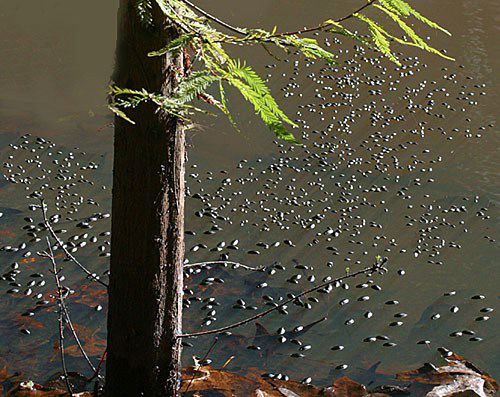|
|
Whirligig Beetle
|
||||||||||||
|
Whirligig beetles are beneficial bugs because the adults eat other dead or dying insects that get trapped on the surface of a lake or pond. They are scavengers that keep the surface of water ways clean. The larvae prey on other insects that live in the water. Whirligig beetles like to swim in large groups on the surfaces of water. They can live in ponds, swamps, bogs, lakes, streams and rivers. They get the name "Whirligigs" from their ability to swim very quickly and whirl around on the surface of the water. If you disturb them, Whirligigs dive under the water to safety. Whirligig beetles are active and feed during the day. There are some videos linked below that show you how Whirligigs swim.
Besides the way that they swim in water, Whirligigs have two other unusual characteristics. They carry an air bubble around with them on the tip of the abdomen and they breathe the air in that bubble when they are under water. Carrying around an air bubble lets whirligigs stay under the water for long periods. When they come up to the surface of the water, whirligigs replace their old bubble for a new one with more air in it. The other unusual characteristic is their "chemical defense system". They give off an odor that smells a little bit like apples. Some predators don't like the chemical odor that they give off, so the smell can protect Whirligigs from being attacked. WhurThreatsNot threatened at present. ConservationConservation action has not been targeted at this species.
Find out moreFor more on invertebrates and their conservation see Buglife,
the Invertebrate Conservation Trust at: Authentication
This information is awaiting authentication by a species expert,
and will be updated as soon as possible. If you are able to help
please contact:
arkive@wildscreen.org.uk
Glossary
References
Whirligigs are small beetles that are metallic black in color with orange legs. The larger ones are about 3/8 inch long and the small ones are only about 1/4 inch long. They use their middle and hind legs are modified for swimming. They have a broad, flattened body with a fringe of hairs. The have two pair of unusual eyes. One pair of eyes is above the surface of the water, and one pair of eyes is below surface. This allows them to see above and below the waterline at the same time. Whirligig larvae have long bodies with long thin legs. RangeFound throughout central Europe and Britain (1).
HabitatInhabits most forms of water bodies, including ponds, ditches and rivers (3). BiologyThis whirligig beetle is active during the day, and is often found in large numbers, whirling around on the surface of the water; when disturbed they are able to dive to safety. They carry an air bubble around with them on the tip of the abdomen, which is periodically replenished, and enables them to stay submerged for long periods. During autumn, the adults fly at night in search of new ponds. In July and August the larvae undergo pupation on land, protected by a cocoon of plant matter and sand grains; the adults emerge 10 days later. Both the larvae and adults are predatory, taking prey such as mosquito larvae and other aquatic invertebrates (4). ThreatsNot threatened at present. ConservationConservation action has not been targeted at this species.
Find out moreFor more on invertebrates and their conservation see Buglife,
the Invertebrate Conservation Trust at: Authentication
This information is awaiting authentication by a species expert,
and will be updated as soon as possible. If you are able to help
please contact:
arkive@wildscreen.org.uk
Glossary
References
ThreatsNot threatened at present. ConservationConservation action has not been targeted at this species.
Find out moreFor more on invertebrates and their conservation see Buglife,
the Invertebrate Conservation Trust at: Authentication
This information is awaiting authentication by a species expert,
and will be updated as soon as possible. If you are able to help
please contact:
arkive@wildscreen.org.uk
Glossary
References
|


